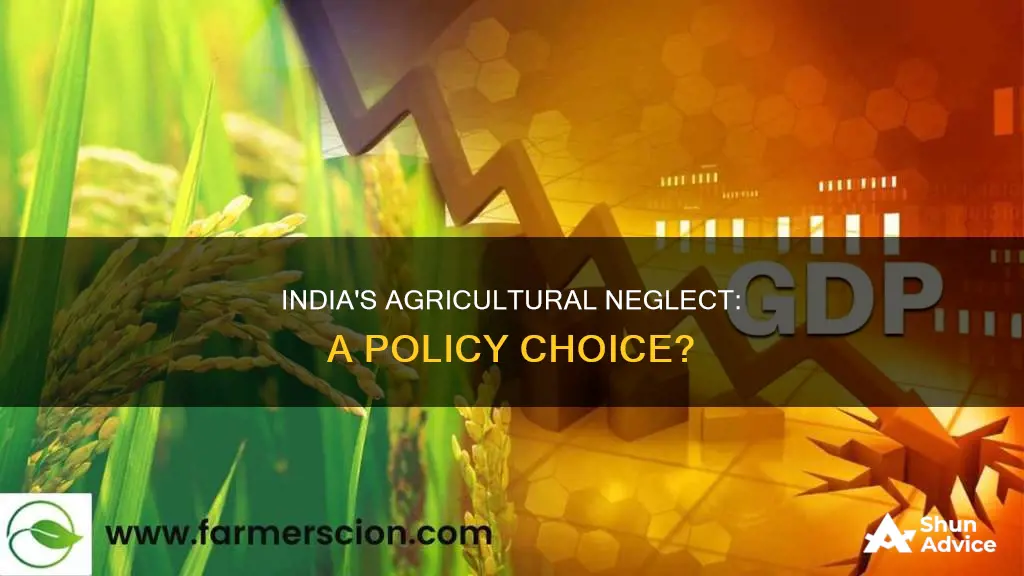
India's agricultural sector is a vital part of its economy, contributing to 18.8% of its Gross Value Added (GVA) in 2021-22. However, the Indian government's investment in agriculture has been a topic of discussion, with some arguing that more needs to be done to support this crucial sector. While the government has implemented various schemes and provided financial assistance, there are concerns about whether these efforts are sufficient to address the challenges faced by farmers and stimulate the necessary growth. This paragraph introduces the topic and sets the context for further exploration of the Indian government's role in investing in and supporting the country's agricultural sector.
What You'll Learn

Lack of investment in agricultural research and extension systems
India's agricultural research and extension systems have suffered from chronic underfunding of infrastructure and operations, with no replacement of ageing researchers or broad access to state-of-the-art technologies. This has led to a decline in the effectiveness of these services over time. Research now has little to offer beyond the time-worn packages of the past, and public extension services are struggling to provide farmers with new knowledge.
There is also too little connection between research and extension, or between these services and the private sector. This lack of communication has resulted in a disconnect between the knowledge being generated and the needs of farmers and the private sector.
The Indian government's spending on agricultural research and extension services has been declining. In 2020-21, India spent about 0.54% of its agricultural gross domestic product on research and 0.11% on extension, much less than the global average. This is despite the fact that every rupee spent on research pays back Rs 13.85, and on extension, Rs 7.40.
The lack of investment in agricultural research and extension systems in India can be attributed to a variety of factors, including:
- Limited government funding and resources: The Indian government has prioritized other sectors, such as subsidies on power, fertilizers, and irrigation, which are now four times larger than investment expenditures.
- Lack of communication and collaboration: There is a disconnect between research and extension services, as well as with the private sector, hindering the effective application of knowledge.
- Aging infrastructure and lack of modernization: The infrastructure supporting agricultural research and extension has not been adequately maintained or upgraded, impacting the quality of these services.
- Inefficient allocation of resources: There is a need for better allocation of resources to priority areas, such as livestock research, which has been neglected in favor of the crop and fishery sectors.
- Inadequate data and evaluation: The lack of quantitative data and evaluation of research resource allocation hinders the ability to make informed decisions and improvements.
To address these challenges, the Indian government and relevant organizations should consider the following strategies:
- Increased investment in agricultural research and development: Prioritize funding for agricultural research and extension services to bring them in line with global averages and recognize the high returns on investment.
- Improved coordination and collaboration: Foster stronger connections between research and extension services, as well as with the private sector, to ensure that knowledge is applied effectively and meets the needs of all stakeholders.
- Infrastructure modernization: Upgrade and maintain the infrastructure supporting agricultural research and extension to ensure that these services have the necessary resources to function effectively.
- Efficient resource allocation: Allocate resources to priority areas, such as livestock research, to address the needs of all sectors, including crops, fisheries, and livestock.
- Data-driven decision-making: Invest in data collection and evaluation to inform resource allocation and improve the overall effectiveness of agricultural research and extension systems.
Client Due Diligence: A Top Priority in Investment Management
You may want to see also

Insufficient water resources and irrigation infrastructure
India's water resources are limited and insufficient for its population. The country has 18% of the world's population but only 4% of its water resources, making it one of the most water-stressed countries globally. This scarcity is exacerbated by the country's dependence on erratic monsoon rains for its water requirements. Climate change is expected to worsen this situation, with increasing temperatures and more frequent extreme weather events such as floods and droughts.
The Indian government has recognised the need to improve water management and has invested in irrigation infrastructure over the past 50 years. However, more needs to be done to ensure efficient water usage and conservation. The World Bank has been supporting the government's efforts by providing financial and technical assistance for various projects, including groundwater management programs, rural water supply initiatives, and urban water supply modernisation.
One of the key challenges in Indian agriculture is the lack of adequate irrigation facilities. According to the Ministry of Agriculture, only about 48% of the total cropped area in India is currently irrigated. This means that most farmers depend on rainfall, which is often erratic and insufficient, leading to irrigation issues. Additionally, many existing irrigation systems are outdated and inefficient, resulting in water loss and wastage.
To address these issues, India can promote water-efficient micro-irrigation systems and construct large-scale irrigation projects and water storage facilities. The government has already taken steps in this direction by implementing irrigation projects and watershed development initiatives. Additionally, the World Bank has supported projects that help farmers in disadvantaged tribal communities build small irrigation facilities, improving their crop yields and livelihoods.
Another issue related to water scarcity is the overexploitation of groundwater, particularly in the agrarian state of Punjab, where tubewell irrigation is causing a drastic decline in the water table. The World Bank has helped the state government pilot an innovative scheme called "Paani Bachao, Paisa Kamao" (Save Water, Earn Money), which incentivises farmers to reduce groundwater usage. The scheme provides cash incentives to farmers who save electricity used for irrigation, resulting in water savings of 6 to 25% without affecting crop yields.
In conclusion, insufficient water resources and inadequate irrigation infrastructure are significant challenges for Indian agriculture. The Indian government and external organisations like the World Bank are working to address these issues through various initiatives and projects. However, more needs to be done to ensure efficient water management and sustainable agricultural practices in the face of increasing water scarcity and a growing population.
Maximizing Cloud Investment: Azure Cost Management Strategies
You may want to see also

Inefficient agricultural marketing and high costs
India's agricultural industry is a massive enterprise, with the country being one of the world's largest producers of agricultural commodities. However, inefficient agricultural marketing and high costs remain significant challenges.
Inefficient Agricultural Marketing
The Indian agricultural marketing system is inefficient, with a large number of intermediaries between the producer and the consumer. This results in high margins for supermarkets, which often have a significant portion of unsold produce at the end of the day. Farmers typically sell their produce only in wholesale markets, while most of the margins are in retail and semi-wholesale. This dynamic means that farmers are unable to capture a larger share of the consumer rupee.
The involvement of intermediaries, such as "arhtiyas" (commission agents), in the marketing process leads to higher costs for farmers. These intermediaries are supposed to facilitate the purchase of agricultural produce but often lend money to farmers at exploitative rates. Their strong lobbies also prevent farmers from selling directly to buyers or agencies.
The Indian government has implemented various measures to improve agricultural marketing, including regulating markets, planning a transparent and simple marketing strategy, and introducing policies such as the Minimum Support Price (MSP) for agricultural products. However, despite government interventions, private traders still dominate the agricultural markets.
High Costs
High costs are another challenge faced by Indian farmers. Small landholdings, resulting from the custom of landowners dividing their land among their children, introduce several difficulties. Farmers with small plots cannot let their land recover between seasons, leading to soil depletion and the need for expensive fertilizers. Small plots also limit the types of farming that can be practiced, such as intercropping, animal husbandry, and commercial crops.
Small private farmers, who often feed their families with their own produce, have limited crops to sell for profit. They rely on middlemen to buy and resell their crops, typically at low prices. The inefficient transportation networks in rural areas further contribute to the high costs faced by farmers.
Food waste is another significant issue, with the UN estimating that $14 billion worth of food is wasted annually in India, amounting to 40% of total farm output. This waste is partly due to deficiencies in the supply chain and food transportation networks, particularly the lack of cold storage infrastructure in rural areas. The harsh Indian summers make it challenging for perishable items to survive long journeys without cold storage.
Water access is another critical issue, as India has a water-scarce country with a rapidly declining water table. The government's subsidies for water-intensive crops like wheat, rice, and sugarcane further exacerbate the problem. Farmers grow these crops almost exclusively due to the stable, non-fluctuating prices offered by the government, while alternate crops often struggle to fetch good prices.
The challenges of inefficient agricultural marketing and high costs faced by Indian farmers have far-reaching consequences. They contribute to food insecurity, with many people going hungry despite the country's high agricultural output. Additionally, these issues hinder the realization of India's full economic potential in the agricultural sector.
Adding Cash to Your Investment Portfolio: Strategies for Success
You may want to see also

Inadequate rural roads and infrastructure
Impact on Agricultural Production and Diversification
Poor rural road infrastructure in India has a significant impact on agricultural production decisions. Limited connectivity in remote regions constrains economic activity and increases costs for farmers. However, improvements in rural road infrastructure can lead to diversification in crop portfolios, adoption of modern agricultural technologies, and increased labor use.
Lack of Funding for Road and Bridge Projects
Rural counties in India often lack sufficient funding for road and bridge projects, resulting in a lack of critical infrastructure to transport agricultural produce from farms to markets. This issue is prevalent in many Midwest counties, where roads and bridges are crumbling under the weight of modern farm equipment and vehicles.
Outdated and Overburdened Infrastructure
The existing rural road infrastructure in India was often built decades ago and is unable to withstand the weight and traffic volume of modern agricultural machinery and vehicles. This leads to roads crumbling, bridges becoming structurally deficient, and an overall decline in the condition of rural roads and bridges.
Impact on Food Security and Poverty Alleviation
India's food security and efforts to alleviate poverty are closely tied to the state of its rural roads and infrastructure. Inadequate roads hinder the transportation of agricultural goods, affecting the supply of food to urban areas and contributing to food spoilage and waste. Additionally, poor infrastructure limits the diversification of crops and the adoption of modern agricultural technologies, impacting agricultural productivity and rural incomes.
Need for Last-Mile Connectivity
Last-mile connectivity in remote areas is crucial to improving economic opportunities for rural communities. By connecting isolated villages to the broader rural road network, the government can facilitate the movement of agricultural goods and increase access to markets, education, healthcare, and other essential services.
Policy Recommendations and Investments
To address the issue of inadequate rural roads and infrastructure, the Indian government should prioritize the following:
- Increase investments in rural road infrastructure, focusing on remote and underdeveloped areas.
- Develop a long-term plan for the maintenance and upgrade of existing roads and bridges to ensure they can withstand modern agricultural equipment and traffic volumes.
- Explore alternative funding sources for road and bridge projects, such as increasing motor vehicle registration fees, property taxes, or fuel taxes.
- Encourage public-private partnerships to leverage expertise and resources for road development and maintenance.
- Promote the adoption of modern agricultural technologies, such as high-yielding crop varieties, to maximize the benefits of improved rural road infrastructure.
Lithium Investment Guide for Indians: Getting Started
You may want to see also

Limited access to credit and high input costs for farmers
Small and marginal farmers (SMFs) in India, who own less than 2 hectares of land, form the backbone of the country's agricultural sector, accounting for 86.2% of Indian farmers. Despite their crucial role, they face several challenges, including limited access to credit and high input costs.
Limited Access to Credit
SMFs in India face significant challenges in accessing formal credit from banks and other financial institutions. Despite the Government of India's policies to encourage agricultural lending, only about 29% of farmers have access to credit from formal sources. This disparity in access to financing is particularly acute for SMFs, with approximately half of them unable to borrow from either formal or informal sources. Those who do borrow often rely on informal credit, which can come with high-interest rates and contribute to a cycle of debt.
Banks' reluctance to lend to SMFs can be attributed to several factors:
- High cost of service: Serving SMFs with small-scale transactions located in remote areas incurs significant costs for banks.
- Limited assessment of creditworthiness: Banks have limited access to financial information, such as cash flows and credit history, of SMFs, making it challenging to assess their creditworthiness.
- Risk of default: Banks perceive a higher risk of default associated with lending to SMFs, which further discourages them from offering credit.
- Uncertainty in policy environment: Loan waivers offered by state governments create uncertainty for banks, as they assume the liability in case of default, potentially reducing credit discipline among farmers.
High Input Costs
The rising cost of agricultural inputs, including seeds, fertilisers, and pesticides, poses a significant financial burden on small farmers in India. Without sufficient capital, farmers may resort to suboptimal input usage, further reducing their productivity and income. Moreover, delays in the sowing season or failure to procure essential input materials can lead to significant losses for farmers, impacting their ability to recover. For example, crops like wheat and rice have specific sowing windows, and missing these can result in reduced yields.
To address these challenges, there is a growing emphasis on improving access to affordable credit for SMFs. Technological interventions, such as AgTech innovations, can play a crucial role in enhancing banks' ability to obtain and verify farmer data, potentially increasing access to finance for SMFs. Additionally, tailored loan products and affordable credit can help mitigate the financial challenges faced by small farmers in India.
Managing Investment Risk: Strategies for Success
You may want to see also
Frequently asked questions
The government of India does invest in agriculture. In the Union Budget 2024-25, a provision of Rs. 1.52 lakh crore (US$ 18.26 billion) was made for the agriculture and allied sectors. The government has also implemented several schemes to support farmers, such as the Pradhan Mantri Kisan Samman Nidhi Yojana (PM-Kisan) and the Pradhan Mantri Krishi Sinchai Yojana (PMKSY).
Agriculture plays a significant role in India's economy. In 2022-23, the agriculture and allied sectors contributed 18.3% to the country's total Gross Value Added (GVA). Agriculture also employs over 50% of India's workforce.
The agriculture sector in India faces several challenges, including soil degradation, nutrition deficiency, natural calamities, inadequate infrastructure, climate change, and loss of harvest.
The government is working towards addressing these challenges by collaborating with other organizations to find cost-effective solutions that safeguard the environment and preserve natural resources. They are also promoting the adoption of new agricultural technologies and providing support to agri-tech startups.
The future outlook for the agriculture sector in India is positive. It is expected that increased investment in agricultural infrastructure, such as irrigation facilities, warehousing, and cold storage, will boost the sector's growth. Furthermore, the growing use of genetically modified crops and the development of new technologies are expected to improve yields for Indian farmers.







